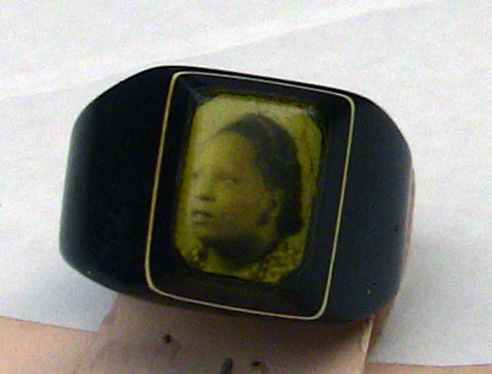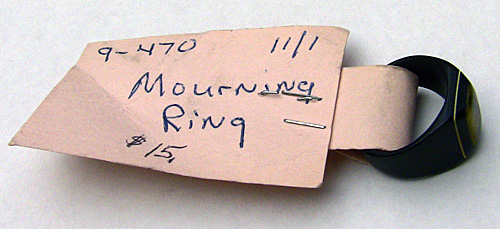I wasn’t paying too much attention to Eric the auctioneer as he peered at a ring in his hand. He was selling jewelry, and I had already looked casually at the carousel of jewelry on the table and seen nothing that had moved me.
Eric was earnestly trying to sell the stuff, so he was eyeing the items in the case much more closely than I had. He saw something on the ring that I had missed, and announced that it was an African American mourning ring as he walked it over for me to see. When you’ve attended auctions long enough, the auctioneers know what you like and buy.
On the front of a black ring was a photo of the face of an African American woman. Now, I was definitely interested and took the first bid on the ring. Another bidder chimed in but soon backed off. I was not going to leave the auction without that ring.

The auction-goer seated to my right – who had been carrying on a conversation far too long with me – dismissed the ring as plastic. Doesn’t matter, I said, because it was African-American-related. It’s hard to find such items at auction, and when I do I have to bid big to obtain them. Black memorabilia sells, and deep-pocket dealers who specialize in it tend to bid at will.
I learned later that the ring was not made of plastic but Bakelite, which was used on mourning rings that held photos in the 1930s and 1940s. The rings were made to mourn the death of a loved one. I can only assume that the woman in the photo was someone’s mother.
Mourning rings were not considered morbid, but an expression of affection and loss – just as photos and other reminders of loved ones who had passed away.
Mourning rings date back to about the 16th century (or 14th or 15th, depending on who you read), and were popularized during the 19th century by Queen Victoria who wore black clothes and jewelry in memory of her husband Prince Albert. They were the most common form of mourning jewelry.

The rings were largely paid for by the deceased through wills, and bequeathed to heirs and friends. They were also manufactured for sale: When George Washington died in 1799, mourning rings were made to honor him. They were also advertised for purchase in newspapers.
The look of the rings varied: Some were plain gold bands, while others had diamonds, pearls and tiny portraits. Usually, they bore the name of the deceased, the day the person died, age and possibly an inscription. By the 19th century, the most expensive were made of an English fossil coal called jet. Some rings also contained hair of the deceased or purchased hair.
Along with rings, the jewelry included brooches, earrings, bracelets and necklaces, and their styles changed as tastes changed. By the 19th century, the rings were mass produced with a photo of the deceased on the bezel (or front of the ring). Mourning rings fell out of favor by the end of the century, but were revived in the 1930s and 1940s.
The ring at auction bore the face of a well-coiffed African American woman and bore no details about her. The antiques shop had attached a tag identifying it as a mourning ring with a price of $15. Too bad the family decided not to keep it.
